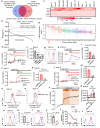Glucocorticoids paradoxically promote steroid resistance in B cell acute lymphoblastic leukemia through CXCR4/PLC signaling
- PMID: 38811530
- PMCID: PMC11136999
- DOI: 10.1038/s41467-024-48818-9
Glucocorticoids paradoxically promote steroid resistance in B cell acute lymphoblastic leukemia through CXCR4/PLC signaling
Abstract
Glucocorticoid (GC) resistance in childhood relapsed B-cell acute lymphoblastic leukemia (B-ALL) represents an important challenge. Despite decades of clinical use, the mechanisms underlying resistance remain poorly understood. Here, we report that in B-ALL, GC paradoxically induce their own resistance by activating a phospholipase C (PLC)-mediated cell survival pathway through the chemokine receptor, CXCR4. We identify PLC as aberrantly activated in GC-resistant B-ALL and its inhibition is able to induce cell death by compromising several transcriptional programs. Mechanistically, dexamethasone (Dex) provokes CXCR4 signaling, resulting in the activation of PLC-dependent Ca2+ and protein kinase C signaling pathways, which curtail anticancer activity. Treatment with a CXCR4 antagonist or a PLC inhibitor improves survival of Dex-treated NSG mice in vivo. CXCR4/PLC axis inhibition significantly reverses Dex resistance in B-ALL cell lines (in vitro and in vivo) and cells from Dex resistant ALL patients. Our study identifies how activation of the PLC signalosome in B-ALL by Dex limits the upfront efficacy of this chemotherapeutic agent.
© 2024. The Author(s).
Conflict of interest statement
S.A.A., J.P.V., and O.B. are designated as inventors for the European Patent application EP23307352 filed on December 22nd, 2023 in the names of Inserm, Université de Rouen, and CHU de Rouen and entitled “methods for preventing resistance to chemotherapy in acute lymphoblastic leukemia”. The remaining authors declare that the research was conducted in the absence of any commercial or financial relationships that could be construed as a potential conflict of interest. OB received research funding and/or honoraria from Argenx, BMS, CSL Behring, Egle Tx, OGD2, and UCB. M.G. received research funding from BridgeMedicines and holds equity of SeqRX. All other coauthors declare no competing interests.
Figures








References
MeSH terms
Substances
LinkOut - more resources
Full Text Sources
Medical
Molecular Biology Databases
Miscellaneous

